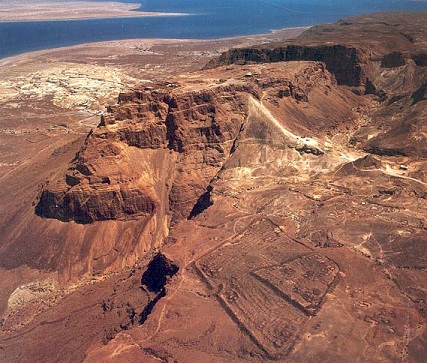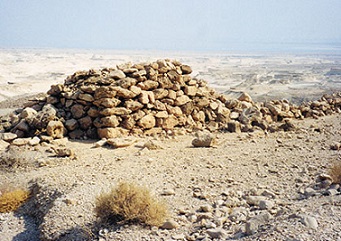Masada—for many, the name evokes the image of a cliff rising dramatically above an austere desert landscape. The name is famously associated with the Masada siege, the final stand between the Jewish rebels and the relentless Roman army at the end of the First Jewish Revolt in 73/74 C.E. Trapped in the desert fortress-palace Herod built in the previous century, the rebels chose—as Jewish historian Josephus tells us—to commit mass suicide rather than be captured and enslaved by the Romans.

The Romans waged both literal and psychological warfare on the Jewish rebels in the siege of Masada. Evidence of the large-scale siege works, including the great assault ramp on the western slope of the cliff of Masada, reflects this strategy. Photo: Werner Braun.
This final scene in the siege of Masada has been celebrated and immortalized as an act of heroic resistance on the part of the Jewish rebels. But what do we know about the Roman siege itself? In “The Masada Siege—From the Roman Viewpoint” in the July/August 2014 issue of Biblical Archaeology Review, Gwyn Davies examines the assault from the Roman perspective.
After the fall of Jerusalem in 70 C.E., the Romans turned their attention to stamping out the last of the rebels holding out at the fortresses of Herodium and Machaerus as well as in the “Forest of Jardes” (which has not yet been identified). The last remaining site occupied by the Jewish rebels was at Herod’s desert fortress-palace on the cliff-top of Masada.
Led by Roman general Flavius Silva, the Legio X Fretensis—a veteran military unit—began the siege operation against the rebels in 72 or 73 C.E.

Archaeological investigations of the Roman siege works at Masada have been much more limited in scope than those conducted on the cliff-top fortress. According to author Gwyn Davies, we must therefore consider both the account given by Josephus and the surviving archaeological evidence in order to reconstruct what happened in the Masada siege.
The Roman army began their assault, as described by Josephus, by throwing up “a wall all around the fortress to make it difficult for any of the besieged to escape, and posted sentinels to guard it” (The Jewish War VII.276). Archaeological investigations reveal that a 2.5-mile circumvallation wall ringed the area around the desert fortress. The wall, composed of rough stone blocks with a rubble core, measured more than 5 feet wide and 10 feet high. Fifteen towers lined the eastern and northern stretches of the circumvallation wall, while eight camps laid down around the wall served as bases and garrison points for the troops.

Fifteen towers, including the one pictured, were mounted with catapults and positioned along the Roman circumvallation wall. Photo: Gwyn Davies.
The most conspicuous surviving evidence of the Roman siege of Masada is the great assault ramp on the western slope of the cliff. The Romans constructed on a natural spur (which Josephus calls the “Leuke,” or “white promontory”) that abuts the mountain a ramp composed of stone and earth reinforced with timber bracings. Josephus tells us that an ironclad siege tower housing a battering ram was hoisted up the ramp and placed into position to strike against the rebels’ casemate wall. Indeed, the location of the breached defense wall lies directly above the modern summit of the ramp. Furthermore, the distribution of stone ballista projectiles discovered within the desert fortress suggests that they were fired from catapults mounted on a siege tower. Setting fire to the wood-and-earth defense wall, the Romans at last made it to the top of Masada.
For a deeper probe into how the Romans waged both literal and psychological warfare on the besieged rebels, read the full article “The Masada Siege—From the Roman Viewpoint” by Gwyn Davies in the July/August 2014 issue of Biblical Archaeology Review.
Subscribers: Read the full article “The Masada Siege—From the Roman Viewpoint” by Gwyn Davies as it appears in the July/August 2014 issue of Biblical Archaeology Review.Not a BAS Library or All-Access Member yet? Join today.
Become a Member of Biblical Archaeology Society Now and Get More Than Half Off the Regular Price of the All-Access Pass!
Explore the world’s most intriguing Biblical scholarship
Dig into more than 9,000 articles in the Biblical Archaeology Society’s vast library plus much more with an All-Access pass.

Related reading in Bible History Daily:
Coins Celebrating the Great Revolt Against the Romans Unearthed near Jerusalem
This Bible History Daily feature was originally published on June 13, 2014.
The post The Masada Siege appeared first on Biblical Archaeology Society.

0 Commentaires